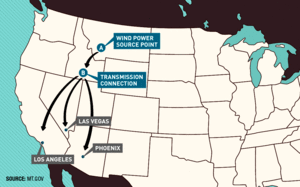
Since the Federal Energy Regulatory Commission approved a rule in 2006 allowing incentive-based rate treatment for transmission work, it has received more than 75 applications for projects totaling $50 billion. Money isn't the issue. The problem with building the lines is exemplified in the Mountain States Transmission Intertie, a $1-billion high-voltage line recently canceled by Northwestern Energy.
Northwestern began developing the project in 2004, when developers with 3,000 MW of projects indicated interest in a line that would move wind power from Montana to Idaho, where it could be distributed via other lines to big markets in the Southwest, including California. Montana is the third-largest wind-energy resource in the U.S., but it has no need for the power within the state and sends very little past its borders.
The business case was strong for a line to move that power out of state, especially after California began contemplating a renewable portfolio standard that would require utilities to obtain 33% of their power from renewable sources. Northwestern began the line application process in 2008.
Winds of Change
But in 2010, Jefferson County, Mont., sued the state and won, claiming it had not been properly consulted in planning for the line. The state won on appeal, but the delay forced the U.S. Bureau of Land Management, which was overseeing the line's environmental impact statement, to scrap the existing study and restart the process.
In the meantime, market dynamics changed. A boom in natural gas, fueled by hydraulic-fracturing technology, quickly produced a gas glut. The surplus undercut the economics of wind power, which also were threatened by the expiration this year of the federal wind-production tax credit. And the California renewable portfolio standard largely excluded wind power from distant states, such as Montana. A weak economy also depressed the demand for any new power sources.
Yet, until earlier this year, Northwestern still believed the line was a good investment. It expected that a draft environmental impact statement (EIS) was imminent.
But this summer, the South Dakota-based utility learned of an unexpected problem: sage grouse in Idaho. The EIS would be delayed at least two years, with no guarantee it would be finished by then.
After eight years and more than $24 million, Northwestern decided last month to pull the plug on the line.
"It was the straw that broke the camel's back," says Mike Cashell, the firm's vice president of transmission. "We just could not get comfortable, we could not see an end in sight. It was just another round of uncertainty."
Delays like the one faced by Northwestern often encourage utilities to take a more conservative approach. "The reason we have a gap in transmission is [that] we have lack of certainty," says Don Mundy, senior vice president for Black & Veatch. "If you fix the certainty, you fix the problem."
As a result, to fix immediate problems, large game-changing transmission projects may be replaced in the short term by smaller and simpler lines.
"What ends up being built is a lot of suboptimal," says John Flynn of the American Transmission Co. "You are proposing a four-lane highway but can only build a series of one-lane roads."

Post a comment to this article
Report Abusive Comment